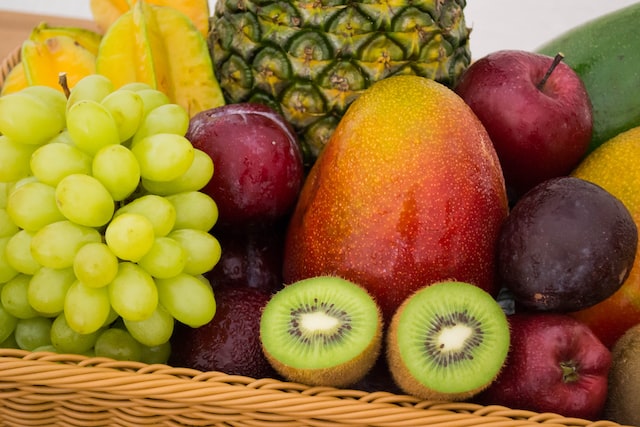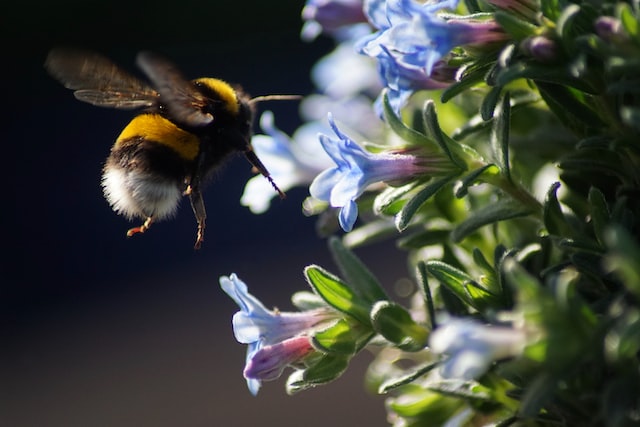
Try to remember what you had for breakfast….
Was it coffee? with cow milk or plant based milk maybe? Maybe also some kind of fruit and nuts? All of these foods rely in one way or another on our world’s pollinating insects. Most of the food we eat, around 80% of the most produced crops actually involve insects in the production of fruit and seeds. Coffee, fruit and nuts? pollinated by bees. Cow milk? The food that the cows eat – is pollinated by bees. Plant based milks… pollinated by bees.
Insect pollination is nature’s way of helping plants reproduce; plants make flowers which insects like bees, butterflies and moths visit. When insects visit, the pollen from the flowers sticks to their bodies and is carried around with them when they visit the next flower, which helps these flowers turn into fruit and make seeds for the next plant to grow.
But of course the plants have to give some kind of incentive for the insects to be attracted to the flowers. So it comes with a trick – flowers are the food source for these insects. Honey Bees, for example, love the nectar that these flowers make, and actually is one of their food sources. They make the nectar into honey, which we humans also eat.
Farmers sometimes rely on wild pollinators to pollinate their crops, sometimes they purchase bees, and sometimes they rent them to do so.
In our agricultural system, the beekeeping sector and crop farms are very much intertwined. Beekeepers rent out their bees for farmers, and farmers in turn pay the beekeepers for their services. Some crops are fully reliant on pollination, or else they would not produce any fruit, some are not as reliant but pollination definitely increases the yields. Depending on the crop, pollination can increase crop production by 20% (but also by 80%!)
But not only that. Pollination also helps improve the taste, vitamin content, size, and visual aspect.
Let’s examine a few crops, and start with one of the most popular crops we see in the supermarket: Apples.
APPLES
Usually either wild bees, honeybees or mason bees pollinate them. Depending on the type of apple tree, but for example in Argentina, they saw an increase of 15%. Not only that, but the apples have a nicer shape and even taste better. As you can see bees play a very important role!
ALMONDS
California is one of the leaders in producing almonds – and honeybees play a very important role there as well. In the USA, there was an increased fruit set by 60%.
PASSIONFRUIT
In Brazil, thanks to honeybees and native Brazilian bees, yields significantly increased and production costs were lowered by 58%
SOYBEANS
Very important crop for many reasons, whether feeding livestock or a very nutritional plant based protein for us. In Argentina, honeybees helped increase the yields by 18%.

Bumblebees are a type of bee that usually live in little groups, but do not produce honey. Here’s a reference picture so we give a face to our main character:
They live in many parts of the world, and there are many different types of bumblebees, but the most “popular” one that helps us humans in the agricultural sector, is Bombus impatiens:
They help us pollinate many many crops, but are mostly used with crops that have the right flower shape that is best adapted by their bigger bodies, and therefore benefit from them more. Their main way of pollinating crops is a type of pollination called buzz pollination, when the bee essentially vibrates, helping the pollen fall around the different parts of the flower, and help the plant produce fruit.
Bumblebees are particularly effective in the pollination of cranberries, blueberries, apples, sweet pepper, and very importantly – tomatoes. Tomatoes are mostly produced in greenhouses, and these round bees are particularly important for these types of farms because they can work in lower light conditions and are better at pollinating in cool or humid environments.
Bees can certainly also pollinate vertical farms, but it may be more challenging for them to do so compared to traditional horizontal farms. Vertical farms are often grown in indoor environments using hydroponic or aeroponic systems, which are different from the natural environments where bees typically pollinate plants.
Additionally, vertical farms often have limited space and may not have the same variety of flowering plants as outdoor environments, which could limit the bees’ access to pollen sources. Moreover, vertical farms often use LED lighting which may not have the same spectrum of light that attracts bees as natural sunlight.
That being said, there are ways to overcome these challenges and facilitate bee pollination in vertical farms. For example, some vertical farms use artificial pollination methods, such as vibrating the flowers or manually transferring pollen, to ensure successful pollination, but that method costs a lot – and is very time consuming. Some farms also use specialized LED lighting that is designed to attract pollinators like bees.
Ultimately, while there may be challenges to bee pollination in vertical farms, it is possible to facilitate it with proper planning and techniques – and that’s what Buzzup is here for.